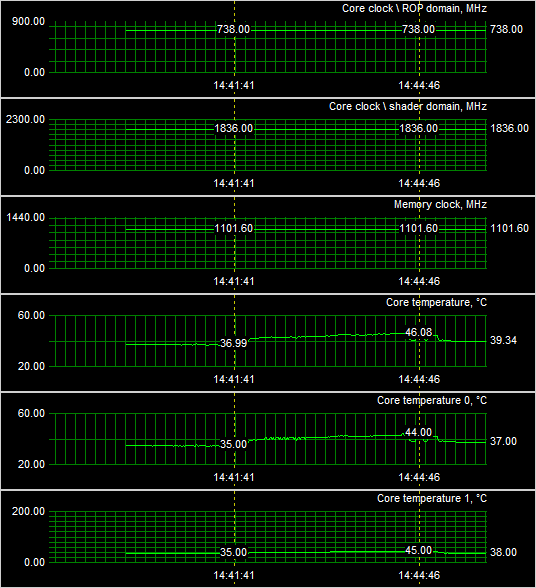8 - GPU heat | Power consumption | Noise levels
Power consumption
Though SLI is real fun and a very fast way to quickly get more performance, it also effectively ads more 'load' on your power bill. Each GeForce 9800 GTX+ can consume up-to ~150 Watts per card when 100% stressed.
Typically this number is lower as your GPU in a lot of situation will not reach that TPD (wattage peak). On average we expect a 150 Watt power draw during gaming, per card.
We'll now show you a tests we have done on overall power consumption of the PC. Looking at it from a performance versus wattage point of view.
The methodology is simple: We have a device constantly monitoring the power draw from the PC. After we have run all our tests and benchmarks we look at the recorded maximum peak; and that's the bulls-eye you need to observe as the power peak is extremely important. Bare in mind that you are not looking at the power consumption of the graphics card, but the consumption of the entire PC.
Our test system contains a Core 2 Duo X6800 Extreme Processor, the nForce 680i mainboard, a passive water-cooling solution on the CPU, DVD-rom and a WD Raptor drive. The results:
- PC 100% usage (wattage gaming Peak) = 437 Watt (SLI)
The monitoring device is reporting a maximum system wattage peak at 437 Watts with SLI. A little higher than our previous reference GTX+ tests where showing. But don't forget, the water-cooling unit will draw power as well.
The thermal envelope
Let's have a look at the temperatures these cards produce. We measured at a room temperature of 21-22 Degrees C, look at the idle temperature and then load the GPU 100% for a couple of minutes and measure the temperature once a second and follow the temperature delta.
The GTX+ as a dual slot product will show pretty nice temperatures due to the nature of the water-cooler. Temperatures: idle 35 degrees C with a 46 degrees C load temperature. That's pretty nice !

Noise Levels coming from the graphics card
When graphics cards produce a lot of heat, that heat usually needs to be transported away from the hot core as fast as possible. Often you'll see massive active fan solutions that can indeed get rid of the heat, yet all the fans these days make the PC a noisy son of a gun. I'm doing a little try-out today with noise monitoring, so basically the test we do is extremely subjective. We bought a certified dBA meter and will start measuring how many dBA originate from the PC. Why is this subjective, you ask? Well, there is always noise in the background, from the streets, from the HD, PSU fan etc etc, so this is by a mile or two not a precise measurement. You could only achieve objective measurement in a sound test chamber.
The human hearing system has different sensitivities at different frequencies. This means that the perception of noise is not at all equal at every frequency. Noise with significant measured levels (in dB) at high or low frequencies will not be as annoying as it would be when its energy is concentrated in the middle frequencies. In other words, the measured noise levels in dB will not reflect the actual human perception of the loudness of the noise. That's why we measure the dBa level. A specific circuit is added to the sound level meter to correct its reading in regard to this concept. This reading is the noise level in dBA. The letter A is added to indicate the correction that was made in the measurement. Frequencies below 1kHz and above 6kHz are attenuated, where as frequencies between 1kHz and 6kHz are amplified by the A weighting.
| TYPICAL SOUND LEVELS | ||
| Jet takeoff (200 feet) | 120 dBA | |
| Construction Site | 110 dBA | Intolerable |
| Shout (5 feet) | 100 dBA | |
| Heavy truck (50 feet) | 90 dBA | Very noisy |
| Urban street | 80 dBA | |
| Automobile interior | 70 dBA | Noisy |
| Normal conversation (3 feet) | 60 dBA | |
| Office, classroom | 50 dBA | Moderate |
| Living room | 40 dBA | |
| Bedroom at night | 30 dBA | Quiet |
| Broadcast studio | 20 dBA | |
| Rustling leaves | 10 dBA | Barely audible |
We start up a benchmark and leave it running for a while. The fan rotational speed remains constant. We take the dBA meter, move away 75 CM and then aim the device at the active fan on the water-cooler.
Now the cards obviously do not make any sound, yet the radiator fan does .. expect normal airflow ~1600 RPM roughly 38-39 DBA, 2400 RPM 44 DBA.
The low RPM setting is however more than enough for cooling down the cards. It's a very good combo. With that in mind .. let's start some games and see how well they perform.
